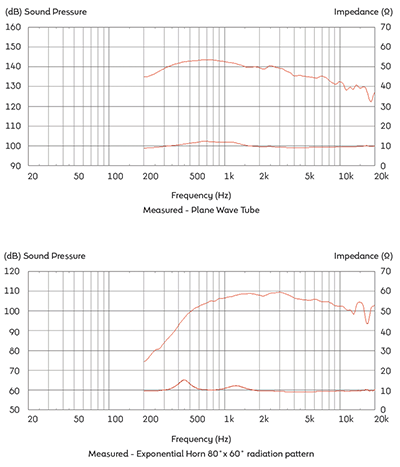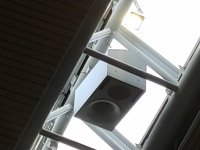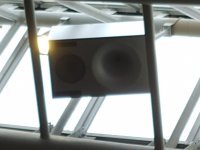You just made me listen to that song. It is not my kind of music though. But it is indeed one that can be used to massage the diaphragm whikle it is also easy on the ear. There are no ear-splitting mids but the mids that are there sound clear and transparent. The latter is not always the case with bass-heavy tracks.
Thanks for the tip.
Regards
Charles
This guy is a decent producer.
Last edited:
Getting back to waveguides for a 15" 2 way solution.
It seems no one ever mentions the possibility of using the DIY Sound Group Waveguides (or complete kits for that matter). Their Fusion 15 (maybe no longer available as a kit) seems to mostly fit the bill for covering the complete range with controlled directivity.
Probably one of their best kits, excellent value for money.
You might consider cloning it.
GM
I did say from the get go that sweet spot was the only listening position that mattered =)
Before I posted my half silly, half serious response, I went back and re-read your first post, which neither stated nor implied a solo seat app, so not from the get-go. Maybe you read your own posts before taking cheap shots.
GM
The chord progressions are really nice but eventually stuff needs to stop falling....
😉
It wasn't so much about the music/composition, but rather his mixing.
(Too much) compression is killing 90% of all music.
Linking to youtube clips is convenient but pretty useless. These are always lossy.
Last edited:
It seems no one ever mentions the posibility of using the DIY Sound Group Waveguides (or complete kits for that matter). Their Fusion 15 (maybe no longer available as a kit) seems to mostly fit the bill for covering the complete range with controlled directivity. At least some of their designs use the DE-250.
Some of the graphs of their waveguides posted elsewhere look nice, but I don't know how much "normalization" or "smoothing" is going on. They're supposedly based on an OS profile.
Every time I look at that website everything of interest is out of stock, specially the waveguides.
Is this some Faital? Which one? Beware of the scale - it's 100 dB, everything will look good at that scale 🙂 I've only a limited experience with Faitals. I quite like Celestion overall - never disappointed me. But as Earl says, it's a comodity... Oh, and did I say I like Eighteensound? 🙂
Yep, scale can be misleading, but after a while you notice it at once.
I like Celestion as well, but they use the same scale 😉
CDX14-3040:

For comparison, B&C DE880TN:

Last edited:
These are crossed at 80Hz to dipole L&R mains
How do you manage the filter phase shift at this frequency ?
Ro808
Frankly I don't look much at these pictures because of all the (unknown) variables, and it's usually only an on-axis measurement which tells you very little anyway. And typically I get better results with the same driver put in a proper waveguide. For me these charts are almost useless - either smoothed or much worse than what you can really get.
Frankly I don't look much at these pictures because of all the (unknown) variables, and it's usually only an on-axis measurement which tells you very little anyway. And typically I get better results with the same driver put in a proper waveguide. For me these charts are almost useless - either smoothed or much worse than what you can really get.
I'm currently at KLIA airport and spotted these. Bass driver is 15-18", the horn is quite a bit bigger. Anyone know what they are?
Attachments
Last edited:
DSP looks after the relative delays on the different channels.How do you manage the filter phase shift at this frequency ?
Wow, what a beast.
Yup. They caught my eye. It might be interesting to find out who did the audio install of the KLIA departure hall. They have hung dozens of these monsters from the roof.😱 The big wg looks like a nice piece.
Sorry, i've don't used the right word (terninology is tricky in the morning)DSP looks after the relative delays on the different channels.
In my head my question was :
How do you manage the filter phase distortion at this frequency ?
It's no different than higher up the frequency range, the relative delays just get longer. Filters are LR24 acoustic.
It's no different than higher up the frequency range, the relative delays just get longer. Filters are LR24 acoustic.
This is also the morning in your country ? The phase distortion has no length.
Last edited:
I'm currently at KLIA airport and spotted these. Bass driver is 15-18", the horn is quite a bit bigger. Anyone know what they are?
Looks like Tannoy VQ or Yorkville Unity, except for the ports
It is actually easier to delay the woofer than the tweeter...An often used method is to use...often Bessel...
Thanks Charles, I came to similar conclusions
I found this old thread when I worked out more-or-less the same result as Marco, decided to try a "6th order Bessel" Low Pass and searched on that....
I have considered cascaded Bessel filters, similar to the way L-R uses cascaded Butterworth, and it looks effective.
A Bessel filter plus an all-pass for extra time delay also looks practicable.
With mine I use a special crossover with flat group-delay and an additional Bessel lowpass whose cutoff is above the crossover frequency to delay the woofer signal.
What "special crossover" is this?
Bessel is maximally flat group-delay so looks optimal to me.
Best wishes
David
Last edited:
David, when you talk about linear phase, do you consider only the direct sound? Because obviously the time delay between drivers will be a function of a spatial coordinate.
At first I only considered on-axis, but I came to think about the off axis response and realised the problem is not simple.
It made me appreciate the benefit's of Earl's OS solution, the compression driver is less offset so the problem is reduced.
I have even considered the Tom Danley's Unity / Multiple Entry Horn solution.
This cleverly fixes the offset but compromises other aspects, not sure if it's worth it despite some impressive systems.
In my experience, what only works in the end is to take the real data ... and play with it for a while.... For me it just works out somehow - and usually not that bad.
Yes, I have played around with a simulator and have acceptable results.
But I am always keen to learn more, especially if someone smart has already solved the problem.
Lipshitz and Vanderkooy did the best analysis I have seen so far, I need to reread it.
Best wishes
Horn seems bigger and more roundovered than VQ or U.Looks like Tannoy VQ or Yorkville Unity,
- Home
- Loudspeakers
- Multi-Way
- Is it possible to cover the whole spectrum, high SPL, low distortion with a 2-way?

